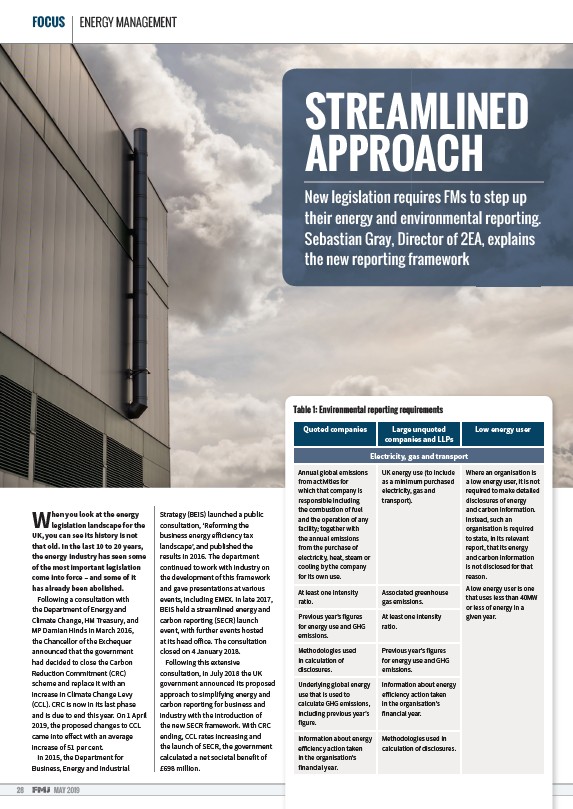
FOCUS ENERGY MANAGEMENT
When you look at the energy
legislation landscape for the
UK, you can see its history is not
that old. In the last 10 to 20 years,
the energy industry has seen some
of the most important legislation
come into force – and some of it
has already been abolished.
Following a consultation with
the Department of Energy and
Climate Change, HM Treasury, and
MP Damian Hinds in March 2016,
the Chancellor of the Exchequer
announced that the government
had decided to close the Carbon
Reduction Commitment (CRC)
scheme and replace it with an
increase in Climate Change Levy
(CCL). CRC is now in its last phase
and is due to end this year. On 1 April
2019, the proposed changes to CCL
came into e ect with an average
increase of 51 per cent.
In 2015, the Department for
Business, Energy and Industrial
28 MAY 2019
Strategy (BEIS) launched a public
consultation, ‘Reforming the
business energy e iciency tax
landscape’, and published the
results in 2016. The department
continued to work with industry on
the development of this framework
and gave presentations at various
events, including EMEX. In late 2017,
BEIS held a streamlined energy and
carbon reporting (SECR) launch
event, with further events hosted
at its head o ice. The consultation
closed on 4 January 2018.
Following this extensive
consultation, in July 2018 the UK
government announced its proposed
approach to simplifying energy and
carbon reporting for business and
industry with the introduction of
the new SECR framework. With CRC
ending, CCL rates increasing and
the launch of SECR, the government
calculated a net societal benefit of
£698 million.
STREAMLINED
APPROACH
New legislation requires FMs to step up
their energy and environmental reporting.
Sebastian Gray, Director of 2EA, explains
the new reporting framework
Table 1: Environmental reporting requirements
Quoted companies Large unquoted
companies and LLPs
Low energy user
Electricity, gas and transport
Annual global emissions
from activities for
which that company is
responsible including
the combustion of fuel
and the operation of any
facility; together with
the annual emissions
from the purchase of
electricity, heat, steam or
cooling by the company
for its own use.
UK energy use (to include
as a minimum purchased
electricity, gas and
transport).
Where an organisation is
a low energy user, it is not
required to make detailed
disclosures of energy
and carbon information.
Instead, such an
organisation is required
to state, in its relevant
report, that its energy
and carbon information
is not disclosed for that
reason.
A low energy user is one
that uses less than 40MW
or less of energy in a
given year.
At least one intensity
ratio.
Associated greenhouse
gas emissions.
Previous year’s figures
for energy use and GHG
emissions.
At least one intensity
ratio.
Methodologies used
in calculation of
disclosures.
Previous year’s figures
for energy use and GHG
emissions.
Underlying global energy
use that is used to
calculate GHG emissions,
including previous year’s
figure.
Information about energy
e iciency action taken
in the organisation’s
financial year.
Information about energy
e iciency action taken
in the organisation’s
financial year.
Methodologies used in
calculation of disclosures.